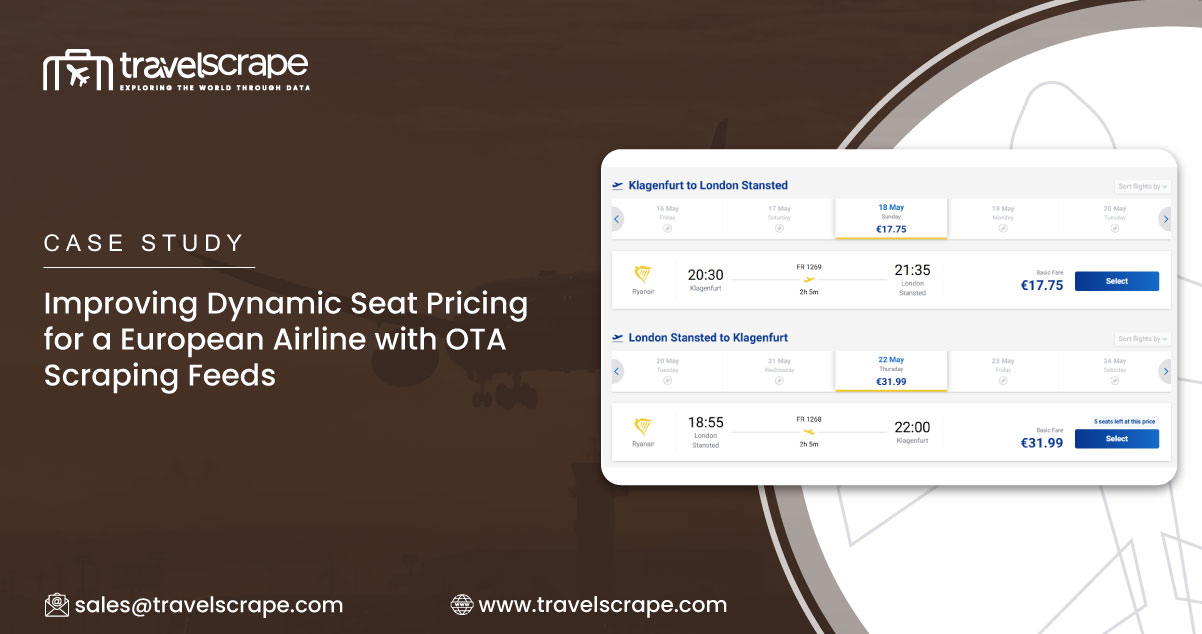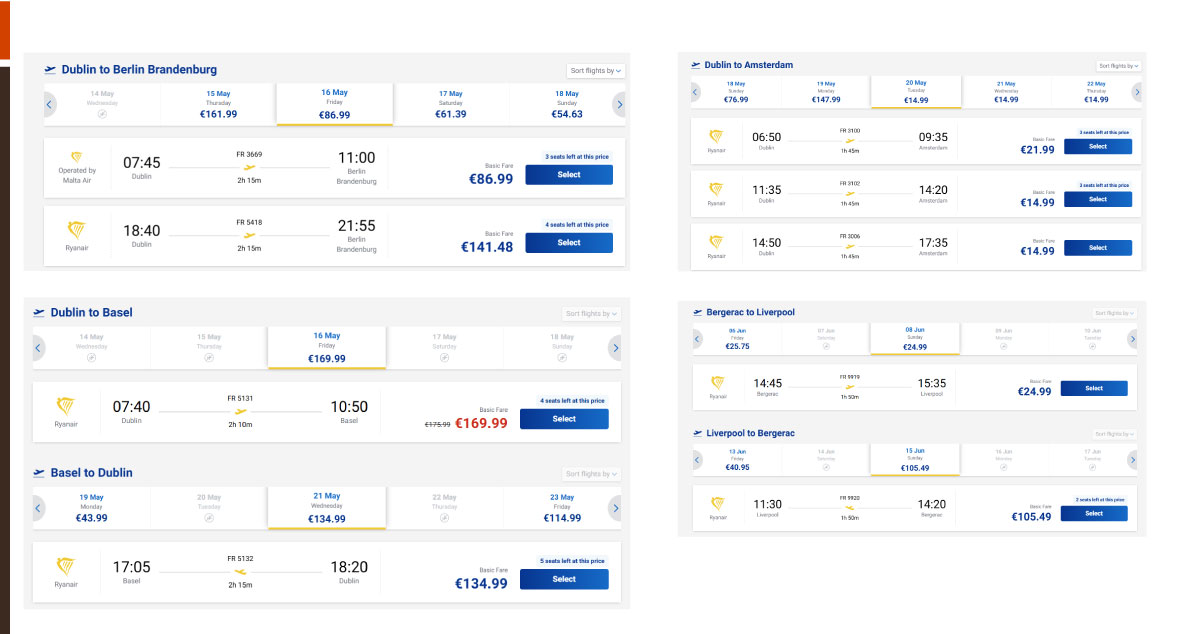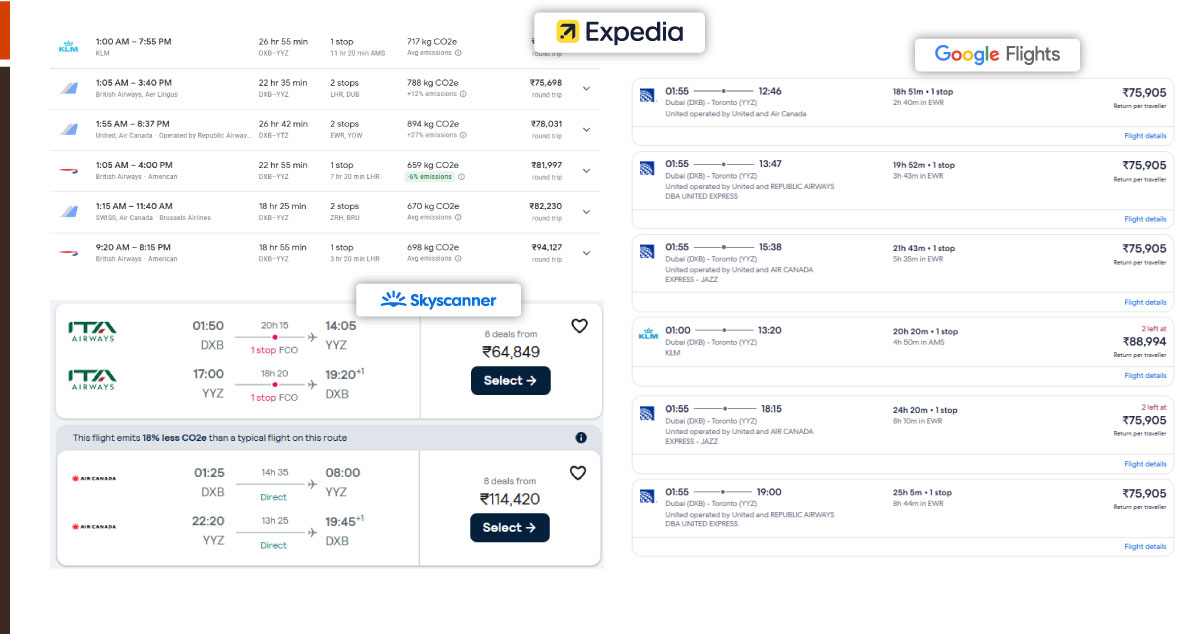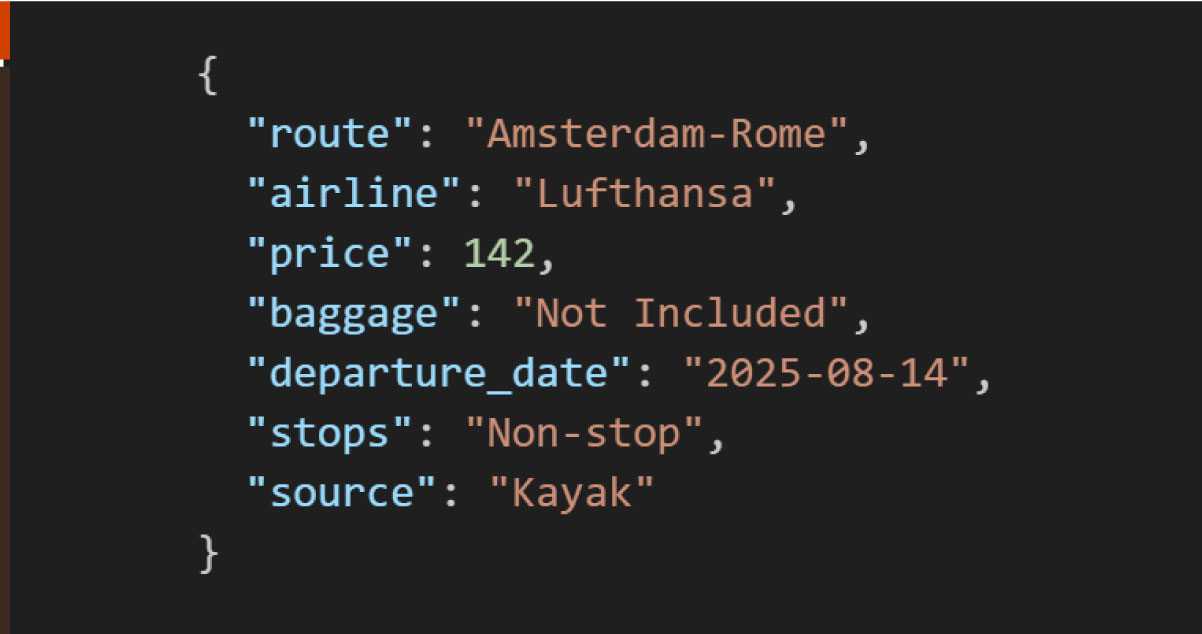Improving Dynamic Seat Pricing for a European Airline with OTA Scraping Feeds

Overview
In the era of algorithmic pricing and cut-throat competition, airlines must constantly adjust seat prices to match competitors and demand shifts. A European carrier partnered with Travel Scrape to create a live data feed from major OTAs to improve their dynamic seat pricing engine .
The result: A 19% lift in revenue per seat sold, fewer empty return-leg seats, and smarter pricing on secondary hubs.
Objectives
- Scrape real-time flight fare data from OTAs across 100+ routes.
- Compare competitor pricing on same routes, same date, same fare class.
- Feed this data into the airline’s dynamic pricing algorithm.
- Flag fare mismatches, pricing delays, or underpriced inventory.
- Improve load factor, especially on less-trafficked city pairs.
Routes Monitored

Focus was on short and mid-haul routes across:
- France
- Germany
- Italy
- Netherlands
- Spain
- Switzerland
- UK
Example Routes:
- Paris → Berlin
- Amsterdam → Rome
- Zurich → Madrid
- London → Milan
- Barcelona → Munich
Why OTA Scraping?

Most airline systems rely on historical booking patterns, internal yield data, and limited GDS visibility. But OTAs like Expedia, Kayak, Google Flights, and Skyscanner reflect actual consumer-facing prices in real time.
Benefits of OTA scraping:
- Visibility into competitor fare shifts
- Discovery of OTA-exclusive offers
- Benchmarking fare buckets and baggage policies
- Access to multi-airline route combinations
Fields Extracted per Route
| Field | Example Value |
|---|---|
| Source / Destination | Amsterdam → Rome |
| Date of Departure | 2025-08-14 |
| Airline | Lufthansa |
| OTA Source | Kayak |
| Fare (Economy) | €142 |
| Class Code | Economy Light |
| Baggage Included | No |
| Stops | Direct |
| Time of Extraction | 08:30 AM CET |
| Booking Link | Kayak URL |
Sample JSON Extract

Travel Scrape’s Scraping Framework
- Scraping Stack: Puppeteer (for JavaScript-heavy OTAs), Scrapy (for static)
- Proxy Rotation: EU-based proxies to simulate accurate regional pricing
- Geo-specific Targeting: Simulated searches from multiple cities/countries
- Frequency: Every 3 hours per route; more frequent on top 25 competitive routes
- Storage: PostgreSQL + Redis (for real-time queueing)
Airline Revenue Management Integration
The scraped data was fed into the airline’s in-house revenue optimization engine, which:
- Mapped competitor fare trends for the next 14/30 days
- Flagged pricing gaps ≥ €25 versus competitors
- Adjusted live fares via API to airline’s booking engine
- Suggested bundled upsell options (baggage, seat selection, meals)
New Trigger Logic Examples:
- “If competitor fare is 10% lower for same time & class → match price”
- “If lowest OTA price is older than 3 hours → hold price advantage”
Results Delivered (within 90 days)
| KPI | Before Scraping Feed | After Travel Scrape Integration |
|---|---|---|
| Avg. Revenue Per Seat | €96 | €114 |
| Fare Match Accuracy vs OTAs | 61% | 92% |
| Empty Seats on Secondary Routes | 18.4% | 11.6% |
| Competitive Undercut Incidents (weekly) | 320+ | <50 |
| Pricing Delay (Competitor Detection) | ~6 hours | <15 minutes |
Data Visualizations
Price Change Heatmap (Amsterdam → Rome – August 2025)
- Lufthansa fluctuated prices 7x in a week
- EasyJet undercut average fares by €18
- Airline adjusted price instantly via feed, capturing 16% more bookings
Fare Sync Lag: Before vs After
| Metric | Before | After (Scrape Feeds) |
|---|---|---|
| Average Fare Sync Delay | 4.8 hours | 12 minutes |
| Missed Competitor Drops | 37/week | <5/week |
Airline Example: Milan → London
Before scraping integration:
- Airline’s fare was €40 higher than average OTA-listed price
- Booking drop by 22%
After scraping:
- Fare aligned to €9 lower than average OTA rate
- Booking rate recovered + 19% in 10 days
Client Testimonial
"We never had real-time insight into OTA fare movements until Travel Scrape came in. Their feeds enabled our revenue team to act faster than our competitors—an absolute game changer."
Technical Stack Overview
| Component | Tools Used |
|---|---|
| Scraping | Puppeteer, Python, Playwright |
| Storage & Pipeline | PostgreSQL, Redis, AWS S3 |
| Pricing Logic Layer | Airline’s proprietary revenue engine |
| Dashboard & Monitoring | Tableau + Grafana |
| Alerts & Sync Logic | Webhooks + Cron scheduler |
Challenges Solved
| Challenge | Travel Scrape’s Solution |
|---|---|
| Rapid OTA Price Fluctuations | Real-time scraping every 3 hours |
| Competitor bundling hidden in UI | Parsed full fare breakdowns (baggage, fees) |
| Geo-price discrepancies on OTAs | Geo-located scraping via proxy networks |
| Seat class code mismatch | NLP classifier to map class equivalence |
| Legacy API sync delays | Built webhook triggers from scrape events |
Use Cases Unlocked
- Airline Yield Managers: Real-time competitor fare alerts
- Pricing Ops Teams: Daily volatility dashboard
- C-Suite Strategy: City-pair pricing trends over time
- Partner OTAs: Synced fare feeds for B2B coordination
Conclusion
With Travel Scrape’s OTA scraping feeds, the European airline was able to bring agility, precision, and automation into their dynamic seat pricing operation. They outpaced competitors not just on price but on timing, often being the first to react in the market.
In an age where pricing is driven by data velocity, scraping OTA listings isn't optional—it’s strategic armor.